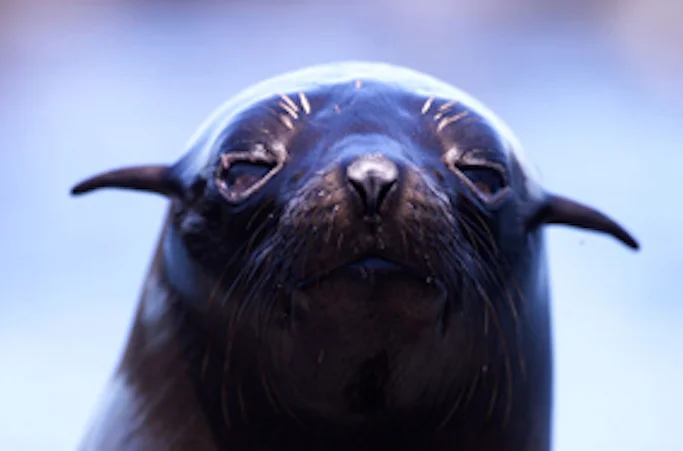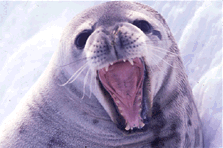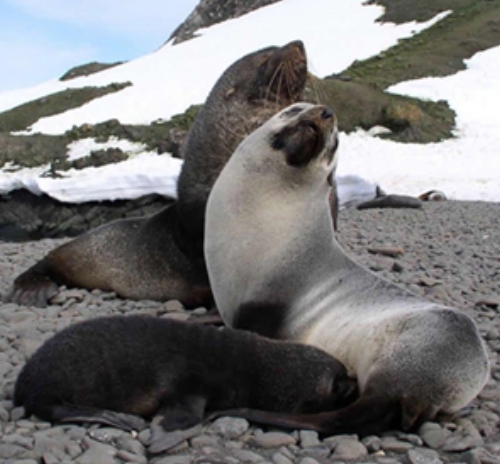Six different kinds of seals live in the Antarctic
All Antarctic seals belong to the group known as true seals
True seals don't have ears
Even without ears, their hearing is good.
Moulting
Most mammals, including human beings, shed hair and skin continuously in small quantities – this is called moulting.
The Antarctic seals have one huge moult just once a year.
They shed an entire layer of skin with hairs. This is because while they are at sea they dive deep down into bitterly cold water. When they do this, blood is kept away from the skin in order to conserve energy and maintain body heat. When the seals come on land to moult, the blood once more circulates to the skin so that a new layer of skin can be grown.
Leopard seals
Leopard seal ©Getty Images
Leopard seals are also known as the sea leopards. They are solitary (live on their own), and inhabit Antarctic and sub-Antarctic regions, but sometimes roam as far north as South America, Australia and New Zealand. They are named for the spotty patterns on their fur and are known as fierce hunters of prey.
They have long, slender bodies and large heads and jaws. The shape of their heads is almost reptilian in appearance. They have large jaws with long and sharply pointed canine teeth, unlike those of most other seals. Males are about 2.8m long and generally weigh 300-600kg, while the females are a bit heavier, between 400-500kg and about 3.5m long.
Leopard seals will eat almost anything and are aggressive hunters.
Unlike any other species of seal, they hunt and kill warm-blooded animals, as well as fish and krill. The favourite food of the leopard seal is the penguin. They chase and grab penguins in the water and thrash them to and fro until the skin peels away, then eat the carcass. They also leap onto the ice to grab their prey and return to the water. The only natural predator of the leopard seal is the killer whale, or orca.
Because they are solitary animals in a vast, isolated place, very little is known about leopard seals, including their breeding. The female leopard seal is pregnant for nine months, and gives birth between November and January. Female leopard seals jump onto the pack ice when it is time to give birth. The baby seals weigh about 40 kg and double in size within the first three months of life. Baby leopard seals are rarely seen.
Elephant seals
Male elephant seal, the largest of the pinniped family. ©Getty Images
Elephant seals get their name from the adult males, which have a nose that looks rather like a short elephant trunk.
Southern elephant seals are found all around Antarctica and breed on sub-Antarctic islands including South Georgia, Peninsula Valdez, Heard Island, and Macquarie Island.
Adult male southern elephant seals can weigh up to 3000kg and adult females around 300kg. Together with the male walrus, they are the largest of the pinnipeds, which is the family of seals, sea-lions and walrus. Females reach about 900kg just before to giving birth. Pups weigh about 40kg at birth. They are weaned (stop drinking milk) after 24 days, by which time they weigh between 120kg and 220kg.
Elephant seals breed in groups called harems. The strongest males each control a harem of up to 50 females. Once a harem grows to more than this, the dominant male will allow some less strong males to live with the harem. Harems can grow to over 1000 females with over 30 males. The breeding season is September to November. Elephant seals do not feed during the breeding season, so their thick layer of blubber keeps them going during that time.
Southern elephant seals feed on squid and fish. Generally alone, they travel long distances. They dive constantly while at sea. They can dive to over 1500m in depth and can stay underwater for up to 2 hours. However, most dives last about 30 minutes to depths between 300 and 800m. In between dives they spend just a few minutes at the surface. Adult elephant seals return to sub-Antarctic islands some time during January to April to moult.
Elephant seals were once hunted for their blubber, which was almost as prized as that of the sperm whale. The blubber was boiled down into oil, which was used for lighting oil lamps, among other things.
Crabeater seal. ©Getty Images
Crabeater seals
These seals spend their entire lives on the pack ice surrounding Antarctica. They rest, breed and moult on the pack ice, and feed in the surrounding water. They generally move southwards in spring, and northwards in autumn, as the pack ice gets bigger or smaller with the seasons.
Crabeater seals are the most numerous seal species in the Southern Ocean.
Males and females are similar in size, weighing about 400kg and reaching about 2.5m in length. They feed mainly on krill, and are able to dive to depths of up to 250m, although they usually feed around 20m from the surface.
Crabeater seal ©Getty Images
Crabeater seals breed on the ice from late September to early November. During the breeding season a male mates with a female and generally stays with her until the time her pup is weaned, but takes no part in rearing the pup. Females give birth to a single pup which is weaned 3-4 weeks after birth. During this time the female spends the entire time on the ice with the pup. Leopard seals are a major predator of crabeater seals, particularly of young pups. Crabeater seals moult during January and February, spending most of that time on the ice.
Antarctic fur seals
Antarctic fur seals with pup ©Getty Images
Antarctic fur seals breed mainly on sub-Antarctic islands, including South Orkney, South Shetland, South Georgia, South Sandwich, Bouvet, Iles Kerguelen, Heard, Marion, Iles Crozet, and Macquarie. Adult male Antarctic fur seals can weigh up to 200kg, adult females about 40 kg, and pups weigh 3-7 kg at birth.
Fur seal pup showing that they are eared seals. ©Getty Images
Male Antarctic fur seals (bulls) establish territories by fighting with other males. The dominant males each control a portion of beach from the water’s edge to the line of vegetation. Territorial bulls give off a strong musk smell during the breeding season. Females are not gathered into harems, and choose a place on the beach. The males then discourage the females from moving to other male territories. Pups are born from late November to early January and are suckled for about 4 months. Some fur seals feed mainly on krill, while others feed mainly on fish and squid. They can dive to more than 100m, but generally dive to around 30m. They stay underwater for 2 to 5 minutes.
Weddell seals
Female Weddell seal and pup. ©Getty Images
Weddell seals are earless seals that live under the permanent ice that surrounds the Antarctic coast. There they are fairly safe from predators such as killer whales and leopard seals. Both adult males and females are about 3m long and weigh around 400-500kg. Their heads are small and their colour is usually blackish grey on the back with a paler underside.
Weddell seals breathe air through cracks and holes in the ice. There are many cracks in the ice during the warmer summer months. During winter these openings freeze over and the seals use their teeth to scrape open the new ice to make holes through which to breathe. This wears down their teeth over the years to the extent that they may eventually be unable to feed or keep the air holes open. In the darkness under the ice, their navigation skills must be very accurate in order to find breathing holes before they run out of breath.
Weddell seal pups.©Getty Images
Weddell seals come out onto the ice to rest and moult, and for females to give birth. When out on the ice, they stay close to the hole in the ice that they came out of. During the breeding season males defend underwater territories from other males for access to breathing holes and females. Pups are born in October weighing 25-30kg. Their mothers care for them for six weeks, during which time they grow to 110-140kg.
Weddell seals are carnivores. Their food varies according to the season and location, but fish, octopus and prawns are their common food. The seals are able to remain underwater for up to 45minutes, diving to about 720m in search of prey. Long shallow dives are probably exploration dives searching for new ice holes and food sources.
Read the kidcyber pages:
Read more about Antarctic seals, including the rare Ross seal:
https://www.activewild.com/antarctic-seals/










